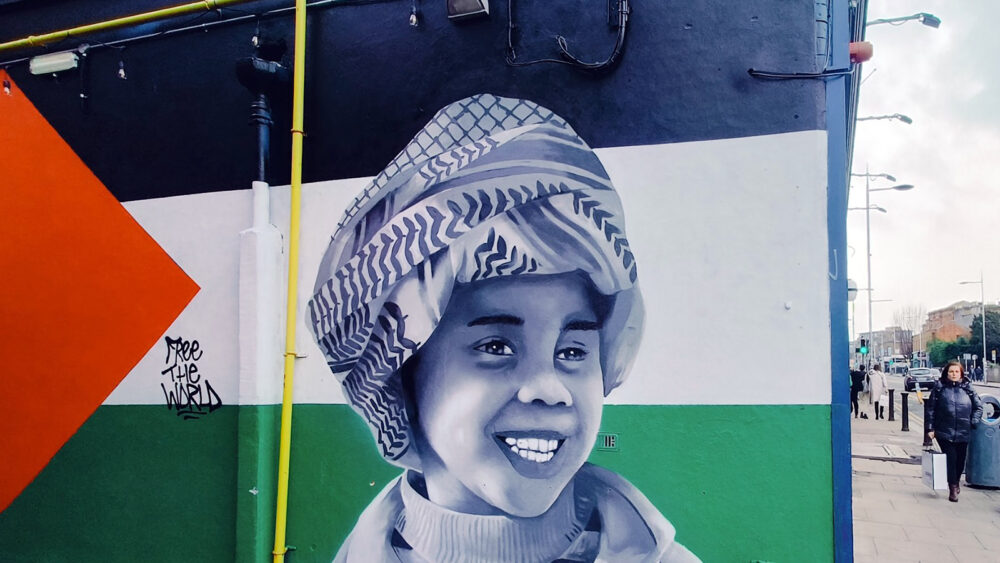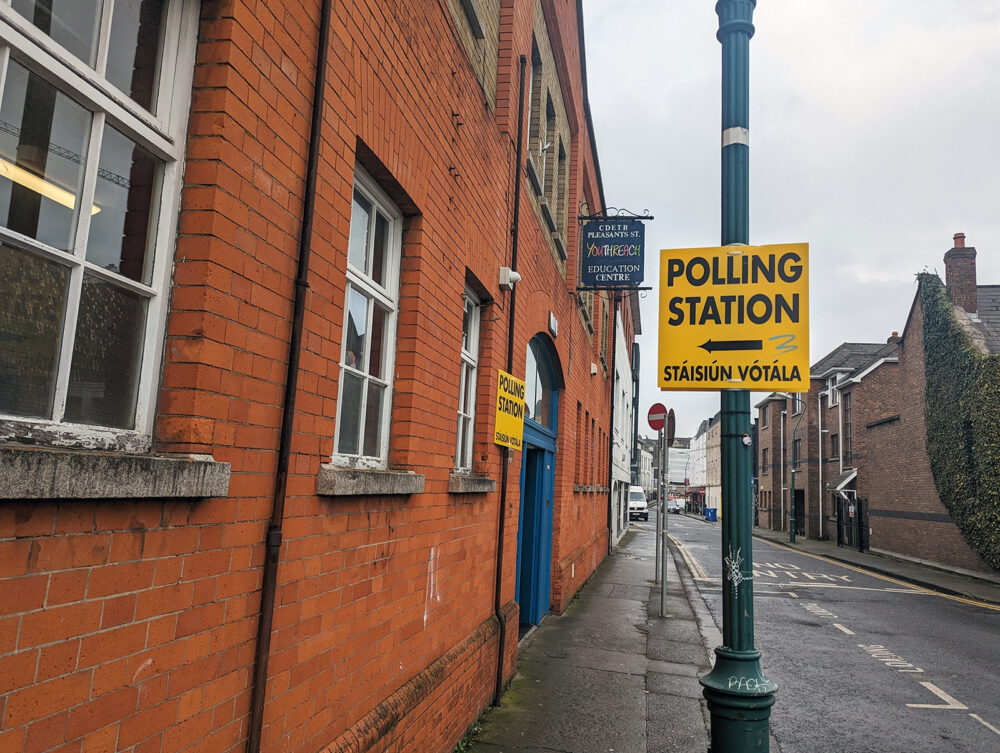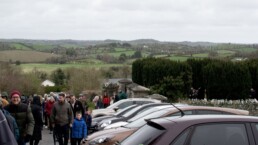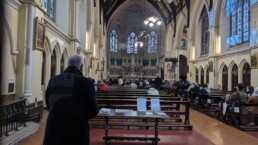For Irish Muslims, Eid al-Fitr is a ‘Mixture of Happiness and Sadness,’ As All Eyes on Gaza
DUBLIN (RNS) — The Islamic Cultural Centre of Ireland was decorated with festive lights on the inside and outside as Ali Selim was getting ready for the morning prayers on Wednesday (April 10), to celebrate the Muslim holy day of Eid al-Fitr. In the corners of the center, stations with sweets and tea and coffee were set up. Outside, smoke wafted out of white tents where vendors had gathered to sell food. Muslims from all over Dublin gathered after a night of celebrating Eid, which marks the end of Ramadan’s month of fasting, prayer and charity.
This year, however, the normally festive celebrations of Eid held a bitterness to them — as in Muslim communities around the world, the month of Ramadan had been shaped by the ongoing war in Gaza. It’s been an omnipresent topic in the mosque, said Selim, an Irish theologian and spokesperson for the Islamic Cultural Centre in Dublin.
“Eid is usually a day that is marked with happiness and joy,” Selim said. “But the mind can never be clear from the sadness over what is happening in Gaza.”
For six months, as the war between Israel and Hamas has raged in Gaza, Irish Muslims, some with family in Gaza, have lived in daily fear as the death toll in Gaza has mounted, surpassing 32,000, according to Gaza’s Ministry of Health.
“Every night we had to offer condolences to someone who lost a family member in Gaza,” Selim said. “Tomorrow (the morning after Eid), they will be with us. It will be very unique in the sense that it is sadness and rejoice at the same time.”
Selim had been hopeful as many around the world called for a cease-fire during Ramadan. “Everybody hoped that the crisis would be over,” he said of the war that began in the aftermath of the Hamas attacks on Israel Oct. 7, which left an estimated 1,200 Israelis and foreigners dead and 250 taken hostage in Gaza.

On March 25, the U.N. Security Council passed a resolution that demanded a cease-fire during Ramadan. On the same day, U.N. Secretary-General Antonio Guterres asked for a massive aid supply, with officials estimating that more than half a million people in Gaza are “one step away from famine.” No cease-fire was ever implemented during Ramadan.
Selim said that over the course of Ramadan, the Islamic Centre raised funds for people in Gaza and organized talks every night to heighten awareness of what is happening there. Several members of the congregation traveled to Gaza during Ramadan to deliver medical aid and returned with testimonies of the situation on the ground.
The purpose of Ramadan fasting, Selim said, is to “share the feeling with those who are deprived or marginalized.” This year, the “deprived or marginalized” on everyone’s mind are those in Gaza. Leaders of Muslim countries around the world made references to Gaza in their Ramadan announcements.
“There wasn’t a single day that Gaza was not part of our prayers,” Selim said.
It was not just Selim who focused his prayers on Gaza this Ramadan in Dublin, where just under half of Ireland’s more than 80,000 Muslims live.
“This Ramadan I think is more special than any Ramadan because of what’s happening in Gaza,” Lorraine O’Connor said. “We relate to what is happening to our brothers and sisters there.”

O’Connor is the founder and director of Muslim Sisters of Eire, a nonprofit organization in Dublin. With her organization, she provides a soup kitchen for the homeless of Dublin every week, provides educational training about Islam and aims for more dialogue between different religions. O’Connor was raised as a Catholic but converted to Islam in 2005.
Islam is the third-fastest-growing religion in Ireland, with the number of Muslims in Ireland growing 32% between 2016 and 2022.
Ramadan has been different from the start this year, said O’Connor.
Normally, she said, Ramadan prayers are for personal forgiveness, or for your family and friends. O’Connor said that she had been suffering from a chest problem and prayed for it to be over during the first evening of Ramadan. But doing so, she said that she immediately wanted to shift the focus of her prayer to the people in Gaza. “I felt a little bit selfish,” O’Connor said. “You want to turn your focus on the genocide that’s happening.”
The Muslim Sisters of Eire has organized several evenings this month to raise awareness and funds for people in Gaza, she said.
At Trinity College Dublin, Ruman Riaz of the Muslim Students Association has tried to raise awareness as well. Riaz is 23 and originally from Kashmir, India, a place where Muslims have had long-standing tensions with the Indian government. Riaz said he finds it frustrating that despite the efforts his organization and others are making, there are few changes.
“There is a sense of helplessness, you know, we can’t really do anything,” Riaz said. At the same time, the solidarity of Muslims for Gaza makes the community grow stronger, he said. “We all pray together for them, fundraise for them, and that just makes us even closer.”
The last 10 nights of Ramadan are believed to carry more reward than any day before, especially Laylat al-Qadr, the “Night of Power,” which this year fell on April 6. Muslims pray and ask for forgiveness the whole night of Laylat al-Qadr. Some do it privately at home and some attend congregations in mosques, Riaz explained.
“In mosques we usually end our prayers with a long supplication of asking God for forgiveness collectively,” Riaz said. “I’m pretty sure that every mosque will pray for Gaza.”
The faithful came to the Islamic Cultural Centre early Wednesday to sing the seven takbirs, or glorifications of God, until the time of the Eid prayer. The prayer was followed by a word from the imam, who began his Eid sermon by congratulating the community on finishing their fast. Then he turned to the continuing suffering in Gaza. Selim called his message “a mixture of happiness and sadness.”
“And it’s a mixture of thinking of those killed and those who are still threatened with death,” Selim said. “It’s a crazy situation.”

The Islamic Centre organized two prayer gatherings for the morning of Eid. Each attracted approximately 3,000 people, according to Selim. Selim added that, despite everything, there was still a festive mood.
“I saw somebody from Gaza this morning. I know he lost extended family members,” Selim said. The man said to Selim that some had managed to go back to where their houses had once been, and though they live in tents now, they have managed to connect water.
“Their message is ‘You can’t finish us, we will rebuild what they have destroyed,’” Selim said.
First published in Religion News Service.
At St. Patrick Pilgrimage, Northern Irish Protestants and Catholics Light Kindling of Unity
SAUL, Northern Ireland — Divisions along religious lines were heavy on the mind of Georgina Magine as she joined about 150 others for a drizzly prayer pilgrimage in County Down on the eve of St. Patrick’s Day.
“We’re all divided in Northern Ireland, but we all claim St. Patrick,” said Magine, a first-timer at the pilgrimage after having learned about it from a friend.
The annual St. Patrick’s Day Prayer Pilgrimage at Down & Dromore, a Church of Ireland diocese, is a two-mile walk from Saul Church, where tradition has it that St. Patrick established his first church when he visited Ireland in the 4th Century. It concludes at Down Cathedral, where the saint’s purported tombstone is located.
According to tradition, Patrick was kidnapped from his home in Britain at 16 and brought to Ireland. After six years of captivity — where he looked to religion for solace — Patrick escaped back to Britain. But upon returning to his homeland, he experienced a revelation where he was told to go back to Ireland and spread Christianity among the people.
While many St. Patrick’s Day parades involve floats, shamrocks and beer, this one is all about prayer and reconciliation.
After leaving Saul Church, marchers stopped at four different spots along Saul Road to pray, led by Pastor David Leggee, a Christian evangelist and preacher.
“We need repentance and we need to intercede for our land,” he said to the group. “We need to be a generation that seeks the Lord.”
At the second stop, Magine huddled in with a small group of strangers outside of a SPAR Supermarket. As she bowed her head and closed her eyes, she lifted her voice and asked God to bring an end to sectarianism in the country.
Although the Good Friday Agreement put an end to sectarian violence in Northern Ireland, deep divisions over the impact of the conflict linger — dozens of “peace-walls” divide Catholic and Protestant neighborhoods, and less than 10 percent of students in the region attend religiously integrated schools, according to The Council on Foreign Relations. But St. Patrick is foundational to both Protestants and Catholics in the country, and the commonality often plays a role in interfaith initiatives, especially in County Down.
The patron saint of Ireland is believed to have brought Christianity to the country long before the Reformation. And although he wasn’t Irish, his story became closely tied to Irish identity.
Rev. Jackie Breen, an ordained deacon at the Roman Catholic Saul & Ballee Parish, who took part in the day’s festivities, said growing up in County Down around the sites associated with St. Patrick put the saint at the forefront of his own faith journey.
Breen said several members of his own congregation were dispersed among the crowd at the pilgrimage while he stood as a member of the clergy representing Catholics at the ecumenical service following the pilgrimage.
He also noted that Downpatrick is unique to the rest of the country in that there is more harmony between the two faiths. Local churches are accepting of Patrick’s place in both Protestant and Catholic faiths, even throughout The Troubles, he said.
“It was a privilege for me to be there to bear witness of our mutual friendship that has sustained throughout the years, and to give witness to that wider community in Ireland of our acceptance of Patrick’s place in our shared faiths,” said Breen.
Many people make this pilgrimage year after year. Jenny Williams, chief executive of Habitat for Humanity Ireland, is a regular at the prayer walk. “It’s just a really special thing to do on St. Patrick’s Day because Patrick wanted to shine the light of the Gospel in Ireland,” said Williams. “It’s an important thing to do every year to remember that.”
Stephen Rutherdale came to the pilgrimage with his young family. The last time they attended in 2018, it was snowing and his second eldest was only nine months old. Now, they’re a family of six with one more on the way, he said.
“We really enjoy this,” said Rutherdale. “This is a great way to meet up with other people from different churches across the diocese.”
Even as the country has become more secular, with a referendum being signed to end the Catholic Church’s special position in the Constitution in 1975, the St. Patrick’s Day celebrations are still well attended.
The Rev. George Okikiolu said he moved to Northern Ireland from Nigeria 12 years ago to explore cross-cultural ministry. Since then, he’s witnessed a decrease in church attendance, he said. “Faith is being affected with the growing culture and secularism in the community,” said Okikiolu.
In response, this year’s pilgrimage theme was on revival and lighting a fire of the Christian faith in the land of Ireland.
The Rev. Jan Stevenson, community pastor at Ballyholme Parish Church, said the theme parallels a story about St. Patrick who lit a flame on the hill of Tara as an act of defiance against the Druids. She said St. Patrick claimed the fire for God rather than the Druid king, and this fire became a metaphor for Christianity in Ireland.
As people walked out of the service at Down Cathedral, a small bonfire burned to signify the spread of the Christian faith the leaders and believers were longing for.
“We would believe that the fire of Patrick has never been put out,” said Stevenson. “And the Christian faith continues in Ireland.”
Unexpected Defeat of Referendums Shows Growing Power of Ireland’s Traditional Catholics
DUBLIN (RNS) — At a Mass said in Latin on Sunday (March 10), Ireland’s traditional Catholics declared political victory, days after a pair of referendums aimed at secularizing the Irish Constitution were unexpectedly and resoundingly defeated.
On Friday, the Irish government put two measures to a vote that would have extended the rights of unmarried couples in the country’s constitution and removed language defining women’s roles “within the home.” Both had been widely expected to pass despite enjoying little debate in the Dail, or Irish parliament, and after a rubber stamp by all three of the Irish Republic’s main political parties.
Both proposals failed, even in progressive Dublin. When all votes were counted, 67.7% of voters had rejected the family amendment, while 73.9% rejected the measure dealing with women’s roles, referred to as the care amendment. Turnout was 44.4%.
On Sunday, as pundits and reporters struggled to explain the most strongly rejected referendum in the republic’s history, roughly 200 traditional Catholics, many in their 30s and 40s, gathered at St. Kevin’s Church, Harrington Street, one of the few places in the city where the traditional, pre-Vatican II Latin Mass is still celebrated, for a triumphant celebration and a redoubt of conservative Catholics.
Even as a much smaller crowd arrived for the noon English-language Mass, those who had attended the 10:30 a.m. Latin Mass — men in tweed jackets and women in long skirts and white, floral head coverings — packed into the tight parish hall for tea, still buzzing with delight at the vote.

The Latin Mass was largely done away with by the Second Vatican Council, when bishops meeting in Rome from 1962-1965 instituted Masses in local languages. However, some traditional Catholics remain drawn to the old Latin rite that dates to the 1500s.
That rite, which was allowed to be said more widely under Pope Benedict XVI, has become a flashpoint under Pope Francis, who in 2021 barred priests from saying it without permission from their bishops. Traditionalists have seen it as a symbol of the larger battle in the church over matters such as LGBT inclusion and the roles of women.
This divide was on display at the entrance to St. Kevin’s, in copies of Catholic Voice, a traditionalist newspaper whose latest issue looks forward to St. Patrick’s Day on March 17 while urging Irish Catholics to have the “courage” to declare that “liberalism is a sin” and deriding the “myths created by the homosexualist movement.” In a time when the pope is allowing priests to bless people in LGBTQ unions, the paper maintained that those who do not oppose “disordered sexuality” are “straddling Satan’s fence.”
The message that Catholic values are under threat from within the church has hit home in Ireland, where society was overwhelmingly Catholic a generation ago. As of 2022, Catholics made up just 69% of the population, down sharply from 79% in 2016. Weekly Mass attendance among Catholics hovers around one-third nationally, down from over 90% in the 1970s.
Accompanying this transformation have been referendums in which the Irish have legalized divorce (1995), gay marriage (2015) and abortion (2018).
But references to both marriage as a fundamental societal unit and to the roles of women in the home will now stay in the constitution. “It’s a great result for women, for mothers, for the homes and for marriage,” said Maria Steen, a prominent conservative activist. “And I think it’s a real rejection of the government’s attempt to, you know, delete all of that from the constitution.”
Steen ran a brief campaign that framed the removal of motherhood from the constitution as both sexist and anti-Catholic. She said Friday’s election result was a sign that the Irish had “gratitude” for motherhood.

At St. Kevin’s, Michelle McGrath, a conservatively dressed woman in her 40s, said she was unsurprised by the vote result. She attributed it in part to the vagueness of the proposals, which would have equated marriage with other “durable” relationships. “Most people were confused about what it was, really,” said McGrath. “I don’t know what I’m being asked here.”
Confusion about what would be deemed durable relationships seemed to doom the referendum on marriage. In a televised debate on March 5 between Steen and Ireland’s deputy prime minister, or Tanaiste, Micheál Martin, he suggested that the court would decide what constituted durability, which would determine parental rights and inheritances.
McGrath said deeper frustrations were also at play. Steen and the “No” campaign suggested repeatedly that the broadened relationship laws would have facilitated greater immigration into Ireland, which has become increasingly controversial in the once demographically homogenous republic.
“People are starting to find their courage again in Ireland, and the people who’ve been silenced for a very long time are starting to call out the obvious injustices going on,” McGrath said. “The Irish have been put paddy-last, to use the pun, in their own nation. They have been sent to the back of the queue while minorities get the majority.”
Meanwhile, Shane Duffley, an early-middle-aged man with an intense stare, said the proposal on women’s roles was “messing with Irish mammies.”
“You don’t mess with Irish women,” he said firmly, eliciting strong nods from two friends — one a European immigrant with a small child in tow and the other a tall Irishman who, like many younger traditional Latin Mass Catholics, homeschools his kids.
Maggie, a middle-aged woman who declined to give her last name, said the liberalization of Ireland had “radicalized” the country. “Ireland has changed a lot in my lifetime,” she said. “But that doesn’t mean that everything that the government proposes is something that people accept.”
First published in Religion News Service.



